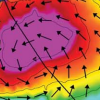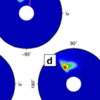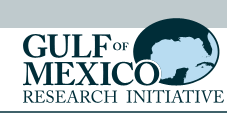
Hurricane Ike (2008) made landfall near Galveston, Texas, as a moderate intensity storm. Its large wind field in conjunction with the Louisiana-Texas coastline’s broad shelf and large scale concave geometry generated waves and surge that impacted over 1000 km of coastline. Ike’s complex and varied wave and surge response physics included: the capture of surge by the protruding Mississippi River Delta; the strong influence of wave radiation stress gradients on the Delta adjacent to the shelf break; the development of strong wind driven shore-parallel currents and the associated geostrophic setup; the forced early rise of water in coastal bays and lakes facilitating inland surge penetration; the propagation of a free wave along the southern Texas shelf; shore-normal peak wind-driven surge; and resonant and reflected long waves across a wide continental shelf. Preexisting and rapidly deployed instrumentation provided the most comprehensive hurricane response data of any previous hurricane. More than 94 wave parameter time histories, 523 water level time histories, and 206 high water marks were collected throughout the Gulf in deep water, along the nearshore, and up to 65 km inland. Ike’s highly varied physics were simulated using SWAN+ADCIRC, a tightly coupled wave and circulation model, on SL18TX33, a new unstructured mesh of the Gulf of Mexico, Caribbean Sea, and western Atlantic Ocean with high resolution of the Gulf’s coastal floodplain from Alabama to the Texas-Mexico border. A comprehensive validation was made of the model’s ability to capture the varied physics in the system.
ME Hope, JJ Westerink, AB Kennedy, PC Kerr, JC Dietrich, CN Dawson, CJ Bender, JM Smith, RE Jensen, M Zijlema, LH Holthuijsen, RA Luettich Jr, MD Powell, VJ Cardone, AT Cox, H Pourtaheri, HJ Roberts, JH Atkinson, S Tanaka, HJ Westerink, LG Westerink (2013). “Hindcast and Validation of Hurricane Ike (2008) Waves, Forerunner,
and Storm Surge.” Journal of Geophysical Research: Oceans, 118, 4424-4460, DOI: 10.1002/jgrc.20314.
 Hurricane Ike (2008) made landfall near Galveston, Texas, as a moderate intensity storm. Its large wind field in conjunction with the Louisiana-Texas coastline’s broad shelf and large scale concave geometry generated waves and surge that impacted over 1000 km of coastline. Ike’s complex and varied wave and surge response physics included: the capture of surge by the protruding Mississippi River Delta; the strong influence of wave radiation stress gradients on the Delta adjacent to the shelf break; the development of strong wind driven shore-parallel currents and the associated geostrophic setup; the forced early rise of water in coastal bays and lakes facilitating inland surge penetration; the propagation of a free wave along the southern Texas shelf; shore-normal peak wind-driven surge; and resonant and reflected long waves across a wide continental shelf. Preexisting and rapidly deployed instrumentation provided the most comprehensive hurricane response data of any previous hurricane. More than 94 wave parameter time histories, 523 water level time histories, and 206 high water marks were collected throughout the Gulf in deep water, along the nearshore, and up to 65 km inland. Ike’s highly varied physics were simulated using SWAN+ADCIRC, a tightly coupled wave and circulation model, on SL18TX33, a new unstructured mesh of the Gulf of Mexico, Caribbean Sea, and western Atlantic Ocean with high resolution of the Gulf’s coastal floodplain from Alabama to the Texas-Mexico border. A comprehensive validation was made of the model’s ability to capture the varied physics in the system.
Hurricane Ike (2008) made landfall near Galveston, Texas, as a moderate intensity storm. Its large wind field in conjunction with the Louisiana-Texas coastline’s broad shelf and large scale concave geometry generated waves and surge that impacted over 1000 km of coastline. Ike’s complex and varied wave and surge response physics included: the capture of surge by the protruding Mississippi River Delta; the strong influence of wave radiation stress gradients on the Delta adjacent to the shelf break; the development of strong wind driven shore-parallel currents and the associated geostrophic setup; the forced early rise of water in coastal bays and lakes facilitating inland surge penetration; the propagation of a free wave along the southern Texas shelf; shore-normal peak wind-driven surge; and resonant and reflected long waves across a wide continental shelf. Preexisting and rapidly deployed instrumentation provided the most comprehensive hurricane response data of any previous hurricane. More than 94 wave parameter time histories, 523 water level time histories, and 206 high water marks were collected throughout the Gulf in deep water, along the nearshore, and up to 65 km inland. Ike’s highly varied physics were simulated using SWAN+ADCIRC, a tightly coupled wave and circulation model, on SL18TX33, a new unstructured mesh of the Gulf of Mexico, Caribbean Sea, and western Atlantic Ocean with high resolution of the Gulf’s coastal floodplain from Alabama to the Texas-Mexico border. A comprehensive validation was made of the model’s ability to capture the varied physics in the system.
 Hurricane Ike (2008) made landfall near Galveston, Texas, as a moderate intensity storm. Its large wind field in conjunction with the Louisiana-Texas coastline’s broad shelf and large scale concave geometry generated waves and surge that impacted over 1000 km of coastline. Ike’s complex and varied wave and surge response physics included: the capture of surge by the protruding Mississippi River Delta; the strong influence of wave radiation stress gradients on the Delta adjacent to the shelf break; the development of strong wind driven shore-parallel currents and the associated geostrophic setup; the forced early rise of water in coastal bays and lakes facilitating inland surge penetration; the propagation of a free wave along the southern Texas shelf; shore-normal peak wind-driven surge; and resonant and reflected long waves across a wide continental shelf. Preexisting and rapidly deployed instrumentation provided the most comprehensive hurricane response data of any previous hurricane. More than 94 wave parameter time histories, 523 water level time histories, and 206 high water marks were collected throughout the Gulf in deep water, along the nearshore, and up to 65 km inland. Ike’s highly varied physics were simulated using SWAN+ADCIRC, a tightly coupled wave and circulation model, on SL18TX33, a new unstructured mesh of the Gulf of Mexico, Caribbean Sea, and western Atlantic Ocean with high resolution of the Gulf’s coastal floodplain from Alabama to the Texas-Mexico border. A comprehensive validation was made of the model’s ability to capture the varied physics in the system.
Hurricane Ike (2008) made landfall near Galveston, Texas, as a moderate intensity storm. Its large wind field in conjunction with the Louisiana-Texas coastline’s broad shelf and large scale concave geometry generated waves and surge that impacted over 1000 km of coastline. Ike’s complex and varied wave and surge response physics included: the capture of surge by the protruding Mississippi River Delta; the strong influence of wave radiation stress gradients on the Delta adjacent to the shelf break; the development of strong wind driven shore-parallel currents and the associated geostrophic setup; the forced early rise of water in coastal bays and lakes facilitating inland surge penetration; the propagation of a free wave along the southern Texas shelf; shore-normal peak wind-driven surge; and resonant and reflected long waves across a wide continental shelf. Preexisting and rapidly deployed instrumentation provided the most comprehensive hurricane response data of any previous hurricane. More than 94 wave parameter time histories, 523 water level time histories, and 206 high water marks were collected throughout the Gulf in deep water, along the nearshore, and up to 65 km inland. Ike’s highly varied physics were simulated using SWAN+ADCIRC, a tightly coupled wave and circulation model, on SL18TX33, a new unstructured mesh of the Gulf of Mexico, Caribbean Sea, and western Atlantic Ocean with high resolution of the Gulf’s coastal floodplain from Alabama to the Texas-Mexico border. A comprehensive validation was made of the model’s ability to capture the varied physics in the system.


 Storm surge due to hurricanes and tropical storms can result in significant loss of life, property damage, and long-term damage to coastal ecosystems and landscapes. Computer modeling of storm surge is useful for two primary purposes: forecasting of storm impacts for response planning, particularly the evacuation of vulnerable coastal populations; and hindcasting of storms for determining risk, development of mitigation strategies, coastal restoration, and sustainability. Model results must be communicated quickly and effectively, to provide context about the magnitudes and locations of the maximum waves and surges in time for meaningful actions to be taken in the impact region before a storm strikes.
Storm surge due to hurricanes and tropical storms can result in significant loss of life, property damage, and long-term damage to coastal ecosystems and landscapes. Computer modeling of storm surge is useful for two primary purposes: forecasting of storm impacts for response planning, particularly the evacuation of vulnerable coastal populations; and hindcasting of storms for determining risk, development of mitigation strategies, coastal restoration, and sustainability. Model results must be communicated quickly and effectively, to provide context about the magnitudes and locations of the maximum waves and surges in time for meaningful actions to be taken in the impact region before a storm strikes.
 As phase-averaged spectral wave models continue to grow in sophistication, they are applied more frequently throughout the ocean, from the generation of waves in deep water to their dissipation in the nearshore. Mesh spacings are varied within the computational domain, either through the use of nested, structured meshes or a single, unstructured mesh. This approach is economical, but it can cause accuracy errors in regions where the input parameters are under-resolved. For instance, in regions with a coarse representation of bathymetry, refraction can focus excessive wave energy at a single mesh vertex, causing the computed solution to become non-physical. Limiters based on the Courant–Friedrichs–Lewy (CFL) criteria are proposed for the spectral propagation (refraction and frequency shifting) velocities in SWAN. These limiters are not required for model stability, but they improve accuracy by reducing local errors that would otherwise spread throughout the computational domain. As demonstrated on test cases in deep and shallow water, these limiters prevent the excessive directional turning and frequency shifting of wave energy and control the largest errors in under-resolved regions.
As phase-averaged spectral wave models continue to grow in sophistication, they are applied more frequently throughout the ocean, from the generation of waves in deep water to their dissipation in the nearshore. Mesh spacings are varied within the computational domain, either through the use of nested, structured meshes or a single, unstructured mesh. This approach is economical, but it can cause accuracy errors in regions where the input parameters are under-resolved. For instance, in regions with a coarse representation of bathymetry, refraction can focus excessive wave energy at a single mesh vertex, causing the computed solution to become non-physical. Limiters based on the Courant–Friedrichs–Lewy (CFL) criteria are proposed for the spectral propagation (refraction and frequency shifting) velocities in SWAN. These limiters are not required for model stability, but they improve accuracy by reducing local errors that would otherwise spread throughout the computational domain. As demonstrated on test cases in deep and shallow water, these limiters prevent the excessive directional turning and frequency shifting of wave energy and control the largest errors in under-resolved regions.
 Hurricane Katrina was historic in magnitude. From ref. 1: “The large size of Katrina throughout its history, combined with the extreme waves generated during its most intense phase, enabled this storm to produce the largest storm surges (reliable observations up to 28 ft) that have ever been observed within the Gulf of Mexico, as determined from analyses of historical records.” The analysis by Grinsted et al. of the effects of rising temperatures on the frequency of Atlantic hurricane surge invokes “events of Katrina magnitude” as a standard by which other events are judged. However, we believe the Katrina benchmark, as used, is seriously flawed, in large part because the tide gauge spatial resolution used was so coarse that none of the locations forming the index ever experienced a true surge event of Katrina magnitude. This casts doubt on the claim that Katrina-level surge events may occur many times per decade by the late 21st century.
Hurricane Katrina was historic in magnitude. From ref. 1: “The large size of Katrina throughout its history, combined with the extreme waves generated during its most intense phase, enabled this storm to produce the largest storm surges (reliable observations up to 28 ft) that have ever been observed within the Gulf of Mexico, as determined from analyses of historical records.” The analysis by Grinsted et al. of the effects of rising temperatures on the frequency of Atlantic hurricane surge invokes “events of Katrina magnitude” as a standard by which other events are judged. However, we believe the Katrina benchmark, as used, is seriously flawed, in large part because the tide gauge spatial resolution used was so coarse that none of the locations forming the index ever experienced a true surge event of Katrina magnitude. This casts doubt on the claim that Katrina-level surge events may occur many times per decade by the late 21st century.

 The Lower Mississippi River protrudes into the Gulf of Mexico, and manmade levees line only the west bank for 55 km of the Lower Plaquemines section. Historically, sustained easterly winds from hurricanes have directed surge across Breton Sound, into the Mississippi River and against its west bank levee, allowing for surge to build and then propagate efficiently upriver and thus increase water levels past New Orleans. This case study applies a new and extensively validated basin- to channel-scale, high-resolution, unstructured-mesh ADvanced CIRCulation model to simulate a suite of historical and hypothetical storms under low to high river discharges. The results show that during hurricanes, (1) total water levels in the lower river south of Pointe à La Hache are only weakly dependent on river flow, and easterly wind-driven storm surge is generated on top of existing ambient strongly flow-dependent river stages, so the surge that propagates upriver reduces with increasing river flow; (2) natural levees and adjacent wetlands on the east and west banks in the Lower Plaquemines capture storm surge in the river, although not as effectively as the manmade levees on the west bank; and (3) the lowering of manmade levees along this Lower Plaquemines river section to their natural state, to allow storm surge to partially pass across the Mississippi River, will decrease storm surge upriver by 1 to 2 m between Pointe à La Hache and New Orleans, independent of river flow.
The Lower Mississippi River protrudes into the Gulf of Mexico, and manmade levees line only the west bank for 55 km of the Lower Plaquemines section. Historically, sustained easterly winds from hurricanes have directed surge across Breton Sound, into the Mississippi River and against its west bank levee, allowing for surge to build and then propagate efficiently upriver and thus increase water levels past New Orleans. This case study applies a new and extensively validated basin- to channel-scale, high-resolution, unstructured-mesh ADvanced CIRCulation model to simulate a suite of historical and hypothetical storms under low to high river discharges. The results show that during hurricanes, (1) total water levels in the lower river south of Pointe à La Hache are only weakly dependent on river flow, and easterly wind-driven storm surge is generated on top of existing ambient strongly flow-dependent river stages, so the surge that propagates upriver reduces with increasing river flow; (2) natural levees and adjacent wetlands on the east and west banks in the Lower Plaquemines capture storm surge in the river, although not as effectively as the manmade levees on the west bank; and (3) the lowering of manmade levees along this Lower Plaquemines river section to their natural state, to allow storm surge to partially pass across the Mississippi River, will decrease storm surge upriver by 1 to 2 m between Pointe à La Hache and New Orleans, independent of river flow.